Abstract
1. Kinin analogues bradykinin (BK), T-kinin, Met-Lys-BK, Lys-Lys-BK, Des-Arg9-BK with agonist activity and D-Arg0-Hyp3-Thi5,8-D-Phe7-BK (DAHTDBK) and Arg9-Leu8-BK with antagonist activity were injected into the posterior portion of the fourth cerebral ventricle of unanaesthetized rats implanted with permanent cannulae and arterial pressure was measured directly from the abdominal aorta. 2. The spontaneously hypertensive rats (SHR) were more sensitive than normotensive Wistar rats (NWR) to the pressor effect of BK and other kinin analogues. The SHR did not differ in sensitivity of the pressor response to centrally administered angiotensin II or endothelin-1. 3. Experiments with selective kinin agonists and antagonists revealed that in the SHR, as in the NWR, the receptors which mediated the central pressor response are of the BK2 subtype. 4. Measurements of the pressor activity of kinins with different degrees of susceptibility to degradation, as well as experiments with kininase inhibitors, enalaprilat and CPP-Ala-Ala-Phe-pAB, suggest that the kininase activity in the central nervous system of SHR is reduced in comparison to that of NWR. 5. The SHR also showed increased sensitivity to BK and Lys-Lys-BK, compared with the NWR, when the kinins were injected following the administration of a mixture of the kininase inhibitors, suggesting that mechanisms other than kininase activity may play a role in the increased sensitivity of the SHR to the central pressor action of kinins. 6. An in vivo characterization of the kinin receptors which mediate the central pressor response showed that the interaction with DAHTDBK was reversible and of competitive nature.(ABSTRACT TRUNCATED AT 250 WORDS)
Full text
PDF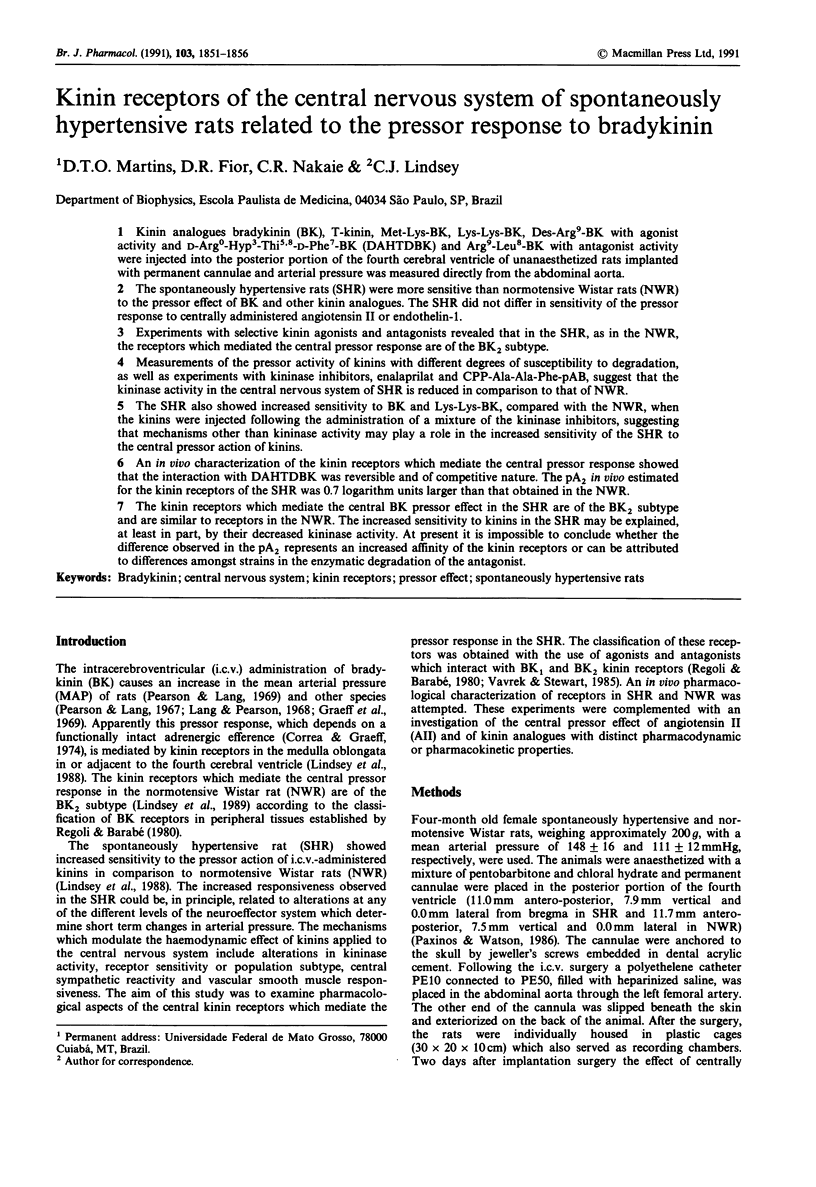

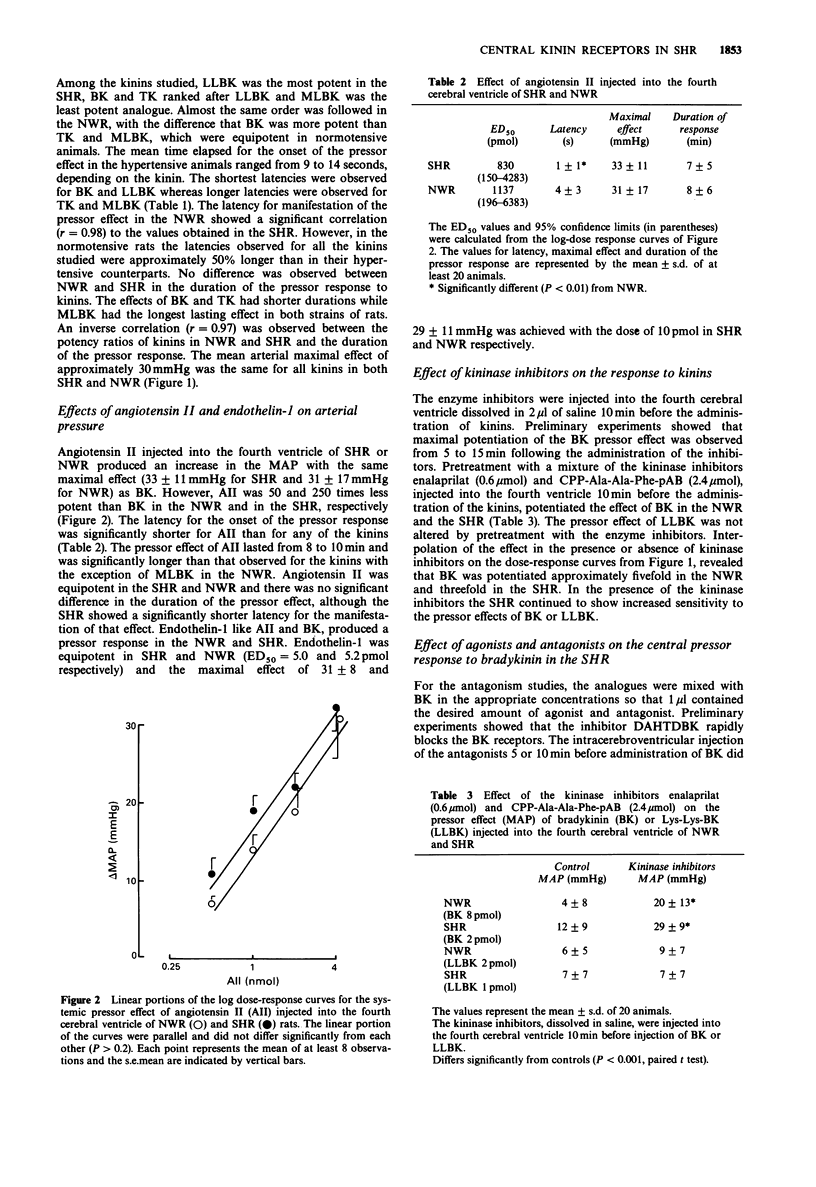
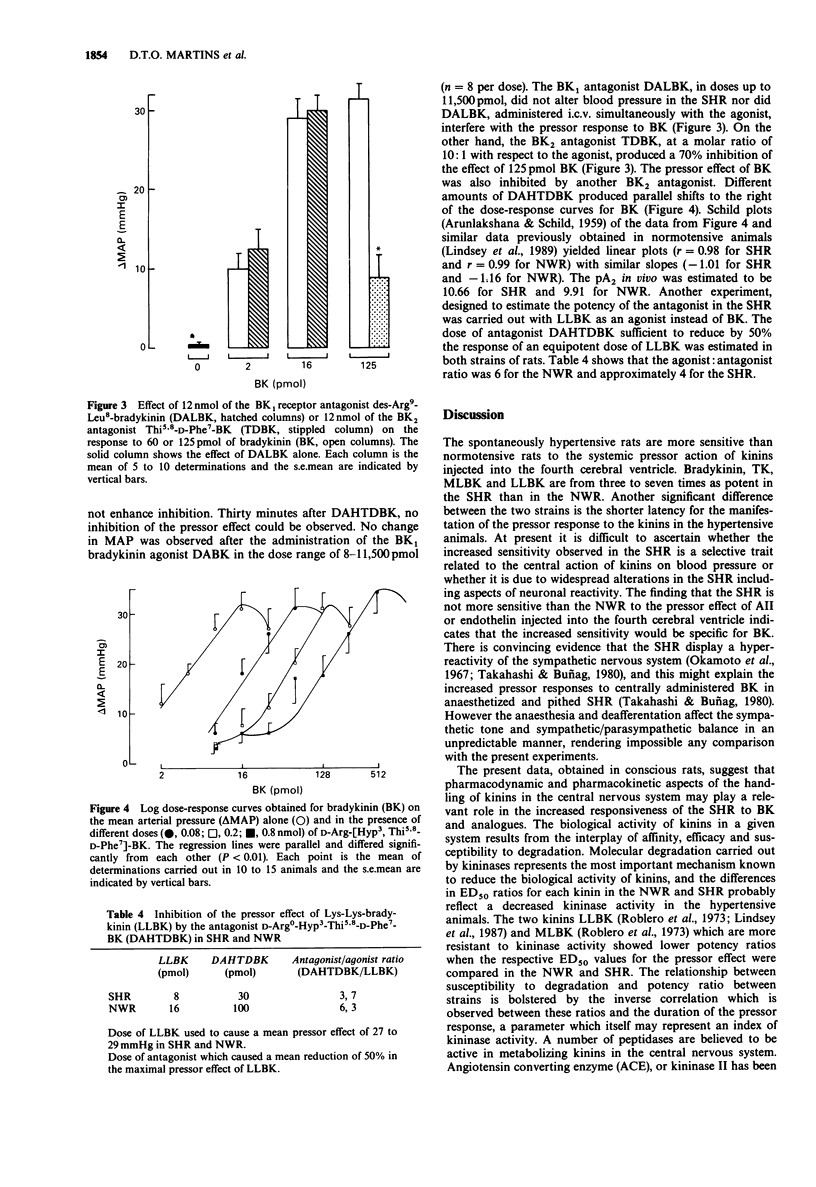
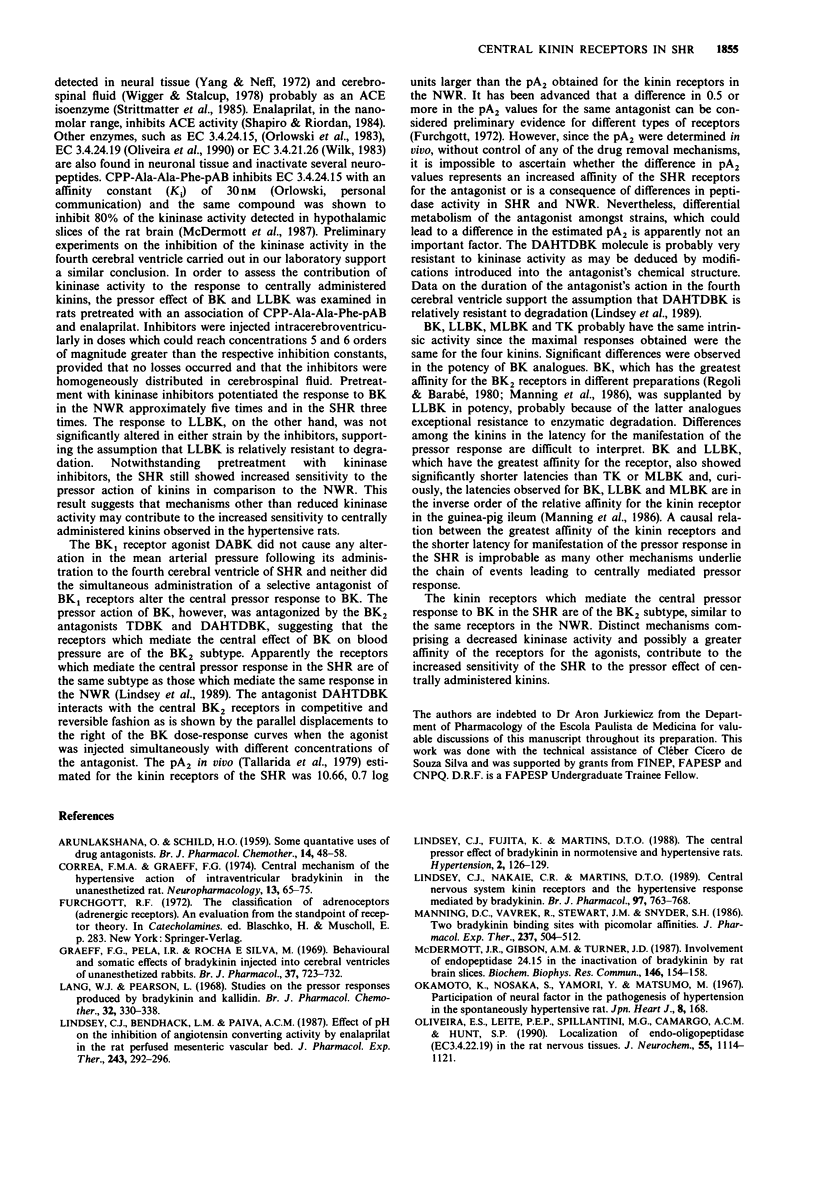
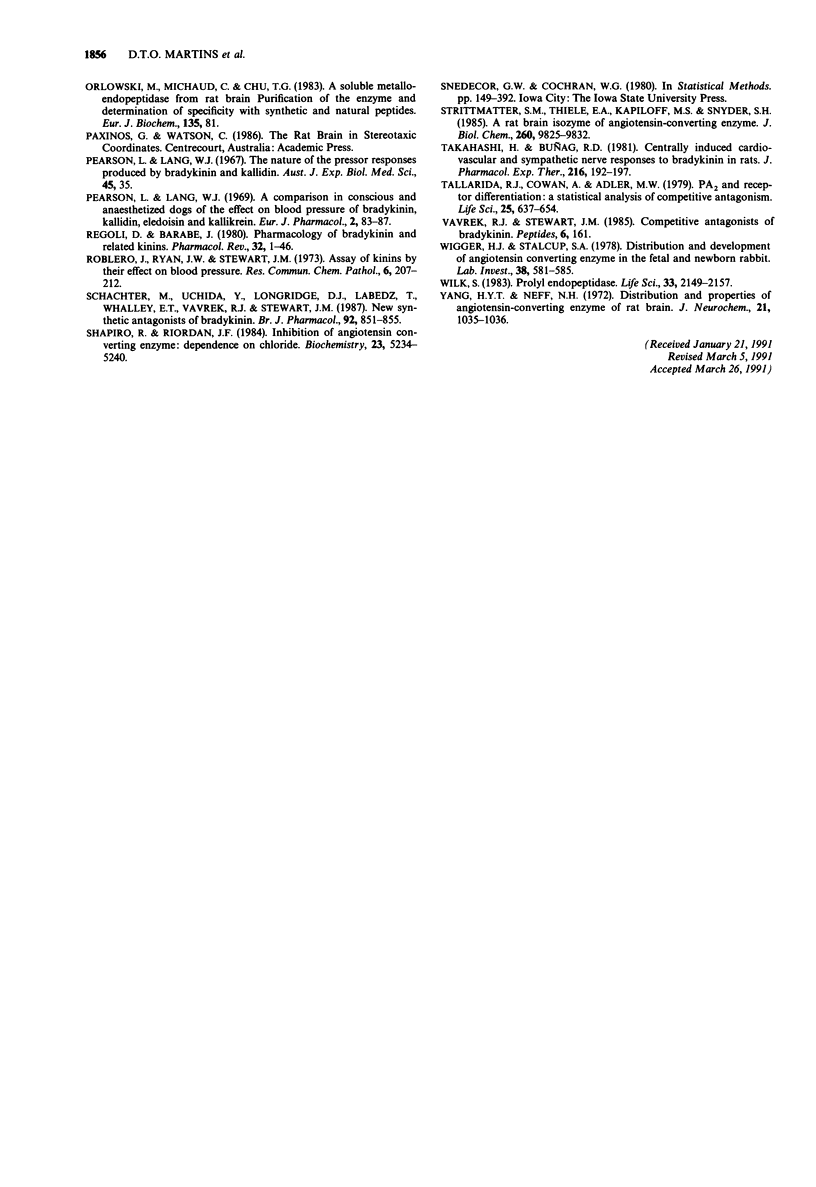
Selected References
These references are in PubMed. This may not be the complete list of references from this article.
- ARUNLAKSHANA O., SCHILD H. O. Some quantitative uses of drug antagonists. Br J Pharmacol Chemother. 1959 Mar;14(1):48–58. doi: 10.1111/j.1476-5381.1959.tb00928.x. [DOI] [PMC free article] [PubMed] [Google Scholar]
- Correa F. M., Graeff F. G. Central mechanisms of the hypertensive action of intraventricular bradykinin in the unanaesthetized rat. Neuropharmacology. 1974 Jan;13(1):65–75. doi: 10.1016/0028-3908(74)90008-2. [DOI] [PubMed] [Google Scholar]
- Graeff F. G., Pelá I. R., Roch e Silva M. Behavioural and somatic effects of bradykinin injected into the cerebral ventricles of unanaesthetized rabbits. Br J Pharmacol. 1969 Nov;37(3):723–732. doi: 10.1111/j.1476-5381.1969.tb08511.x. [DOI] [PMC free article] [PubMed] [Google Scholar]
- Lang W. J., Pearson L. Studies on the pressor responses produced by bradykinin and kallidin. Br J Pharmacol Chemother. 1968 Feb;32(2):330–338. doi: 10.1111/j.1476-5381.1968.tb00976.x. [DOI] [PMC free article] [PubMed] [Google Scholar]
- Lindsey C. J., Bendhack L. M., Paiva A. C. Effect of pH on the inhibition of angiotensin converting activity by enalaprilat in the rat perfused mesenteric vascular bed. J Pharmacol Exp Ther. 1987 Oct;243(1):292–296. [PubMed] [Google Scholar]
- Lindsey C. J., Nakaie C. R., Martins D. T. Central nervous system kinin receptors and the hypertensive response mediated by bradykinin. Br J Pharmacol. 1989 Jul;97(3):763–768. doi: 10.1111/j.1476-5381.1989.tb12014.x. [DOI] [PMC free article] [PubMed] [Google Scholar]
- Manning D. C., Vavrek R., Stewart J. M., Snyder S. H. Two bradykinin binding sites with picomolar affinities. J Pharmacol Exp Ther. 1986 May;237(2):504–512. [PubMed] [Google Scholar]
- McDermott J. R., Gibson A. M., Turner J. D. Involvement of endopeptidase 24.15 in the inactivation of bradykinin by rat brain slices. Biochem Biophys Res Commun. 1987 Jul 15;146(1):154–158. doi: 10.1016/0006-291x(87)90704-2. [DOI] [PubMed] [Google Scholar]
- Okamoto K., Nosaka S., Yamori Y., Matsumoto M. Participation of neural factor in the pathogenesis of hypertension in the spontaneously hypertensive rat. Jpn Heart J. 1967 Mar;8(2):168–180. doi: 10.1536/ihj.8.168. [DOI] [PubMed] [Google Scholar]
- Oliveira E. S., Leite P. E., Spillantini M. G., Camargo A. C., Hunt S. P. Localization of endo-oligopeptidase (EC 3.4.22.19) in the rat nervous tissue. J Neurochem. 1990 Oct;55(4):1114–1121. doi: 10.1111/j.1471-4159.1990.tb03113.x. [DOI] [PubMed] [Google Scholar]
- Orlowski M., Michaud C., Chu T. G. A soluble metalloendopeptidase from rat brain. Purification of the enzyme and determination of specificity with synthetic and natural peptides. Eur J Biochem. 1983 Sep 1;135(1):81–88. doi: 10.1111/j.1432-1033.1983.tb07620.x. [DOI] [PubMed] [Google Scholar]
- Pearson L., Lang W. J. A comparison in conscious and anaesthetized dogs of the effect on blood pressure of bradykinin, kallidin, eledoisin and kallikrein. Eur J Pharmacol. 1967 Nov;2(2):83–87. doi: 10.1016/0014-2999(67)90029-5. [DOI] [PubMed] [Google Scholar]
- Regoli D., Barabé J. Pharmacology of bradykinin and related kinins. Pharmacol Rev. 1980 Mar;32(1):1–46. [PubMed] [Google Scholar]
- Roblero J., Ryan J. W., Stewart J. M. Assay of kinins by their effects on blood pressure. Res Commun Chem Pathol Pharmacol. 1973 Jul;6(1):206–212. [PubMed] [Google Scholar]
- Schachter M., Uchida Y., Longridge D. J., Labedz T., Whalley E. T., Vavrek R. J., Stewart J. M. New synthetic antagonists of bradykinin. Br J Pharmacol. 1987 Dec;92(4):851–855. doi: 10.1111/j.1476-5381.1987.tb11390.x. [DOI] [PMC free article] [PubMed] [Google Scholar]
- Shapiro R., Riordan J. F. Inhibition of angiotensin converting enzyme: dependence on chloride. Biochemistry. 1984 Oct 23;23(22):5234–5240. doi: 10.1021/bi00317a022. [DOI] [PubMed] [Google Scholar]
- Strittmatter S. M., Thiele E. A., Kapiloff M. S., Snyder S. H. A rat brain isozyme of angiotensin-converting enzyme. Unique specificity for amidated peptide substrates. J Biol Chem. 1985 Aug 15;260(17):9825–9832. [PubMed] [Google Scholar]
- Takahashi H., Buñag R. D. Centrally induced cardiovascular and sympathetic nerve responses to bradykinin in rats. J Pharmacol Exp Ther. 1981 Jan;216(1):192–197. [PubMed] [Google Scholar]
- Tallarida R. J., Cowan A., Adler M. W. pA2 and receptor differentiation: a statistical analysis of competitive antagonism. Life Sci. 1979 Aug 20;25(8):637–654. doi: 10.1016/0024-3205(79)90505-8. [DOI] [PubMed] [Google Scholar]
- Vavrek R. J., Stewart J. M. Competitive antagonists of bradykinin. Peptides. 1985 Mar-Apr;6(2):161–164. doi: 10.1016/0196-9781(85)90033-6. [DOI] [PubMed] [Google Scholar]
- Wigger H. J., Stalcup S. A. Distribution and development of angiotensin converting enzyme in the fetal and newborn rabbit. An immunofluorescence study. Lab Invest. 1978 May;38(5):581–585. [PubMed] [Google Scholar]
- Wilk S. Prolyl endopeptidase. Life Sci. 1983 Nov 28;33(22):2149–2157. doi: 10.1016/0024-3205(83)90285-0. [DOI] [PubMed] [Google Scholar]
- Yang H. Y., Neff N. H. Differential distribution of angiotensin converting enzyme in the anterior and posterior lobe of the rat pituitary. J Neurochem. 1973 Oct;21(4):1035–1036. doi: 10.1111/j.1471-4159.1973.tb07554.x. [DOI] [PubMed] [Google Scholar]


